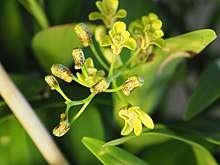Dendrobium gracilicaule
Dendrobium gracilicaule, commonly known as the blotched cane orchid or yellow cane orchid,[2] is an epiphytic or lithophytic orchid in the family Orchidaceae. It has cylindrical pseudobulbs, between three and seven thin leaves and up to thirty often drooping, cream-coloured to yellow or greenish flowers, sometimes with reddish brown blotches on the back. There are two varieties, one occurring in Queensland and New South Wales and the other on some Pacific Islands, including Lord Howe Island.
| Blotched cane orchid | |
|---|---|
 | |
| Scientific classification | |
| Kingdom: | Plantae |
| Clade: | Tracheophytes |
| Clade: | Angiosperms |
| Clade: | Monocots |
| Order: | Asparagales |
| Family: | Orchidaceae |
| Subfamily: | Epidendroideae |
| Tribe: | Dendrobieae |
| Subtribe: | Dendrobiinae |
| Genus: | Dendrobium |
| Species: | D. gracilicaule |
| Binomial name | |
| Dendrobium gracilicaule | |
| Synonyms[1] | |
| |
Description
Dendrobium gracilicaule is an epiphytic or lithophytic herb that has cylindrical, yellowish green pseudobulbs 40–100 cm (20–40 in) long and 4–13 mm (0.2–0.5 in) wide, each with between three and seven leaves on the top. The leaves are thin, dark green, 70–130 mm (3–5 in) long and 20–40 mm (0.8–2 in) wide. The flowering stem is 50–150 mm (2–6 in) long and bears between five and thirty, often drooping flowers. The flowers are cream-coloured to yellow or greenish, 10–16 mm (0.39–0.63 in) long and wide, in one variety with large reddish blotches on the back. The sepals are 7–10 mm (0.3–0.4 in) long, 3–4 mm (0.12–0.16 in) wide and are relatively think and fleshy. The petals are 7–10 mm (0.3–0.4 in) long, 3–4 mm (0.1–0.2 in) wide. The labellum is 7–10 mm (0.3–0.4 in) long, 5–6 mm (0.20–0.24 in) wide and has three lobes. The side lobes curve upwards and the middle lobe is kidney-shaped and has three wavy ridges. Flowering occurs between July and September.[2][3]
Taxonomy and naming
Dendrobium gracilicaule was first formally described in 1859 by Ferdinand von Mueller and the description was published in Fragmenta phytographiae Australiae from a specimen collected by William Hill near Moreton Bay.[4][5] The specific epithet (gracilicaule) is derived from the Latin words gracilis meaning "slender" or "thin"[6]:376 and caulis meaning "stem" or "stalk".[6]:750
There are two varieties of this orchid:
- Dendrobium gracilicaule var. gracilicaule[7] – the blotched cane orchid which has large reddish brown blotches on the back of the flowers and grows on trees or rocks usually in rainforest between Mount Fox in Queensland and the Hawkesbury River in New South Wales.[2][3]
- Dendrobium gracilicaule var. howeanum Maiden[8] – the yellow cane orchid,[2] which lacks spots on the back of the flowers and grows in humid forests on Lord Howe Island, the Kermadec Islands, Fiji, New Caledonia and Vanuatu.[2][8]
References
- "Dendrobium gracilicaule". World Checklist of Selected Plant Families (WCSP). Royal Botanic Gardens, Kew.
- Jones, David L. (2006). A complete guide to native orchids of Australia including the island territories. Frenchs Forest, N.S.W.: New Holland. p. 405. ISBN 1877069124.
- Weston, Peter H. "Dendrobium gracilicaule". Royal Botanic Garden Sydney. Retrieved 23 November 2018.
- "Dendrobium gracilicaule". Retrieved 23 November 2018.
- von Mueller, Ferdinand (1859). Fragmenta phytographiae Australiae (Volume 1). Melbourne: Victorian Government Printer. pp. 179–180. Retrieved 23 November 2018.
- Brown, Roland Wilbur (1956). The Composition of Scientific Words. Washington, D.C.: Smithsonian Institution Press.
- "Dendrobium gracilicaule var. gracilicaule". World Checklist of Selected Plant Families (WCSP). Royal Botanic Gardens, Kew.
- "Dendrobium gracilicaule var. howeanum". World Checklist of Selected Plant Families (WCSP). Royal Botanic Gardens, Kew.
External links
- IOSPE orchid photos, Dendrobium gracilicaule
- Santa Barbara Orchid Estate (Santa Barbara California USA), Dendrobium gracilicaule
- Australian Native Orchid Society (Queensland), Kabi Group, Dendrobium gracilicaule
![]()